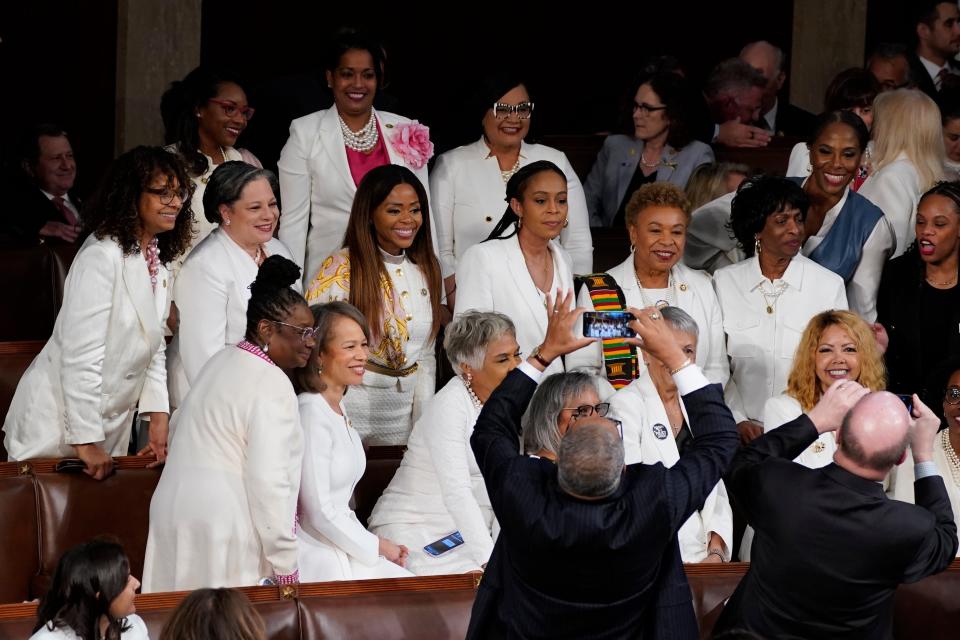Who was the first congresswoman? How Montana Rep. Rankin made history.
- Oops!Something went wrong.Please try again later.
- Oops!Something went wrong.Please try again later.
Women won the right to vote in 1920 when the 19th Amendment was ratified, but three years before that one suffragette became Congress’ first female representative.
The number of women in Congress has grown in recent years, but reports still show little overall progress on equity for women in the workplace.
Women account for the majority of workers in one-third of major U.S. industries but remain largely underrepresented in top leadership positions, USA TODAY reported last year. Disparities in both pay and representation are even worse for women of color.
Who was the first woman in Congress?
Jeannette Rankin was the first woman elected to Congress. The Republican Representative from Montana was elected in 1916 and sworn in on March 4, 1917.
Here are other historic firsts for women in national politics, some of them as recent as the last presidential election:
First woman in the Senate: Rebecca Felton of Georgia (1922)
First woman elected to the Senate: Hattie Caraway of Arkansas (1931)
First female state governor: Nellie Tayloe Ross of Wyoming (1924)
First woman elected as governor (not preceded by spouse): Ella Grasso (1974)
First female White House cabinet member: Frances Perkins (1933)
First female Supreme Court justice: Sandra Day O’Connor (1981)
First woman to be a major-party vice presidential nominee: Geraldine Ferraro (1984)
First female Speaker of the House: Nancy Pelosi (2007)
First female vice president: Kamala Harris (2020)
Read more about the "firsts": Trailblazing women in politics
Who was Jeannette Rankin?
Rankin was a lifelong pacifist who campaigned for social and electoral reform. She was sworn in the same day President Woodrow Wilson took his second oath of office.
Rankin graduated from Montana State University in Missoula (now the University of Montana) in 1902 with a degree in biology. She taught, worked as a seamstress and returned to school at the New York School of Philanthropy, now the Columbia University School of Social Work.
She began her political career as a volunteer with a local women’s suffrage campaign in Washington State. She eventually became a field secretary with the National American Woman’s Suffrage Association.
Between 1910 and 1911, she was heavily involved with the state of Montana’s women’s suffrage resolution, becoming the first woman to address the Montana legislature when she testified in support and “singlehandedly … reviving the state’s long-dormant suffrage movement,” according to the U.S. House of Representatives History, Art and Archives department. Her work helped women’s suffrage become law in Montana in 1914.
“I am deeply conscious of the responsibility, and it is wonderful to have the opportunity to be the first woman to sit in Congress,” she said after winning an at-large House seat in 1916. “I will not only represent the women of Montana, but also the women of the country, and I have plenty of work cut out for me.”
Before the House recessed on the afternoon she was sworn in, Rankin had already introduced her first bill, the Susan B. Anthony amendment, to guarantee and protect women’s suffrage in the Constitution.
Rankin is well-known for her staunch isolationist beliefs. In 1917, she and 49 other members of Congress voted against declaring war on Germany. She was also the only member to vote against U.S. involvement in both World Wars.
Rankin ran for a Senate seat in 1918 because her “no” vote on WWI, plus a new Democratic majority in the district, gave her a slim chance at winning as a representative. After defeat in the Republican primary, she ran unsuccessfully as a third-party candidate.
Rankin served a second House term in 1941, this time alongside six other women.
How many women are in Congress?
Women make up more than a quarter of the voting members of the 118th Congress, the highest percentage in U.S. history and a 50% jump in the past decade. There are 25 women in the Senate and 125 women in the House, USA TODAY previously reported.

The changing face of Congress is reflected in its agenda. The lawmakers – who were honored in 2023 by USA TODAY among the nation's Women of the Year – have elevated research into women's health, reformed the way sexual assault allegations are handled in the military, and pursued issues that affect the daily lives of children.
"When I was first elected, I was mistaken for a spouse on multiple times and told I couldn't enter the floor," Massachusetts Rep. Katherine Clark, the Democratic whip, told USA TODAY last year. That rarely happens today. "When I ran in 2013, I was one of the first campaigns to have majority female donors, and now we see that more routinely."
Women in Congress are also driving an increase in racial and ethnic diversity.
The current Congress includes 31 Black women, 20 Latinas, 11 Asian American/Pacific Islander women and one who identifies as Middle Eastern/North African, according to the Center for American Women and Politics at Rutgers University. In 2018, Rep. Sharice Davids of Kansas became one of the first two Native American women elected to Congress. Last year, Mary Peltola became the first Alaska Native elected to Congress and the first woman the state had elected to the House.
Women of the Year 2024: Meet the women across the country who inspire us
Just Curious for more? We've got you covered.
USA TODAY is exploring the questions you and others ask every day. From "Who controls the Senate?" to "What is the debt ceiling?" to "When was gay marriage legalized?" – we're striving to find answers to the most common questions you ask every day. Head to our Just Curious section to see what else we can answer for you.
Contributing: Camille Fine, Susan Page
This article originally appeared on USA TODAY: First woman in Congress: Meet Jeannette Rankin, a Montana suffragette

